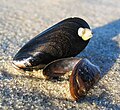Blue mussel
| Blue mussel | |
|---|---|

| |
| Scientific classification | |
| Kingdom: | |
| Phylum: | |
| Class: | |
| Subclass: | |
| Order: | |
| Family: | |
| Subfamily: | |
| Genus: | |
| Species: | M. edulis
|
| Binomial name | |
| Mytilus edulis | |
The blue mussel, here specifically Mytilus edulis, medium-sized edible bivalve mollusc. It is commonly harvested for food throughout the world, from both wild and farmed sources. Blue mussels are found on the North Atlantic coast of North America, Europe, and in other temperate and polar waters around the world.
Blue mussels live in intertidal areas attached to rocks and other hard substrates by strong (and somewhat elastic) thread-like structures called byssal threads; these are secreted by byssal glands located in the foot of the mussel.
The shell is smooth with a sculpturing of fine concentric growth lines but no radiating ribs. The shells of this species are purple, blue or sometimes brown in color, occasionally with radial stripes as shown here.
Blue mussels are preyed upon by starfish such as Asterias vulgaris; small mussels are also eaten by the dogwhelk, Nucella lapillus.
Mussels are a staple of many seafood dishes in Spanish, Portuguese, French, Belgian and Italian.
A related species, the bay mussel, Mytilus trossulus is part of an ongoing long term environmental monitoring program in Prince William Sound, Alaska, the area affected by the Exxon Valdez oil spill. The study examines hydrocarbon signatures in order to have a more complete understanding of ecosystem recovery following the spill.
References
- Department of Marine Resources
- Gilbertson, Lance. (1999). Zoology Laboratory Manual (4th ed.), pp. 11.1-11.4. The McGraw-Hill Companies, Inc.
- Sea Grant
See also
- California mussel (Mytilus californianus)
-
Live blue mussels on a rocky substrate
-
Two empty blue mussel shells on a beach of the Baltic Sea
-
Numerous empty blue mussel shells on a beach in Iceland



